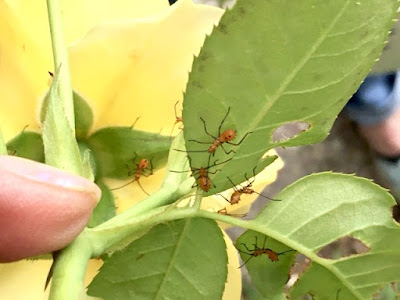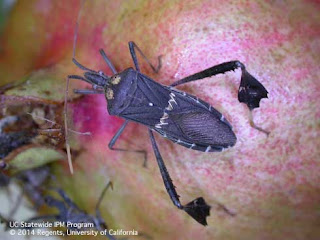
Leaf-footed bugs appear on roses, tomatoes and other juicy plants

|
|
These are leaf-footed bug nymphs. They tend to stay
in a pack when young. (Photo courtesy Alan Moritz)
|
“Good guys or bad guys?” That’s the question that accompanied this photo of mystery insects that suddenly appeared on a rose bush in a Sacramento garden.
Definitely bad guys – and they’re beginning to pop up all over town, especially on tomatoes, soft fruit and roses. The reason? They love triple-digit heat.
Those are nymphs (babies) of the leaf-footed bug, a relative of stink bugs. They'll make holes through your roses (and lots of other things). They’re very bad on tomatoes and can be a pest on apricots and peaches. They also like pomegranates, almonds, pistachios, citrus and watermelons.
Most of their damage is cosmetic, but in big numbers they can be a real nuisance. They puncture the fruit’s skin and suck out its juices.
The good news: They can't fly and they're slow. When young, they stick together. They release a pheromone that keeps the developing bugs in a little pack. (The better to attack your plants.)

|
|
Here's what leaf-footed bugs look like as adults.
(Photo courtesy UC IPM)
|
Like many stink bugs, they're resistant to any pesticides (unless it’s a direct hit). Because the young nymphs are wingless, their instinct is to jump down from wherever they’re dining and scramble for cover.
What to do? Under the plant, put a bucket or dishpan of water with a teaspoon of dish soap (to break the surface tension). Then, gently shake the bush, vine, branch or cane and knock the bugs into the water. (Often, they will just jump when they see your shadow.) They can't swim and they drown.
You also can blast the hell out of them with a hose (you’re watering the plants at the same time). Or you can just squish them, but wear gloves; they'll stain your hands (and they stink).
For more on leaf-footed bugs, check out these recommendations from the UC Cooperative Extension Pest Notes: http://ipm.ucanr.edu/PMG/PESTNOTES/pn74168.html
Comments
0 comments have been posted.Sacramento Digs Gardening to your inbox.
Sites We Like
Garden Checklist for week of July 21
Your garden needs you!
* Keep your vegetable garden watered, mulched and weeded. Water before 8 a.m. to reduce the chance of fungal infection and to conserve moisture.
* Feed vegetable plants bone meal, rock phosphate or other fertilizers high in phosphate to stimulate more blooms and fruiting. (But wait until daily high temperatures drop out of the 100s.)
* Don’t let tomatoes wilt or dry out completely. Give tomatoes a deep watering two to three times a week.
* Harvest vegetables promptly to encourage plants to produce more. Squash especially tends to grow rapidly in hot weather. Keep an eye on zucchini.
* Pinch back chrysanthemums for bushy plants and more flowers in September.
* Remove spent flowers from roses, daylilies and other bloomers as they finish flowering.
* Pinch off blooms from basil so the plant will grow more leaves.
* Cut back lavender after flowering to promote a second bloom.
* It's not too late to add a splash of color. Plant petunias, snapdragons, zinnias and marigolds.
* From seed, plant corn, pumpkins, radishes, winter squash and sunflowers.